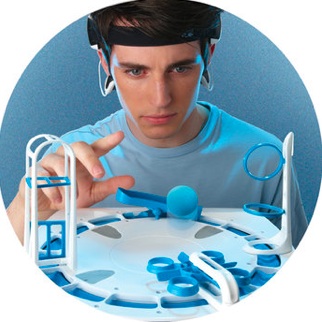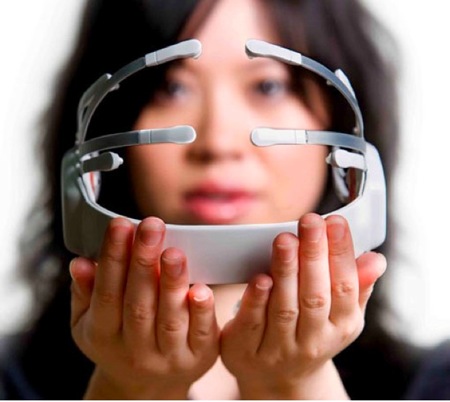
The Future Present of Brain InterfacingJohn Mitchell
Figure 1: The brain Recent work in the field of neuroscience has produced consumer devices that can reliably interface the brain with computers. More and more, these devices are being used as unique inputs for games. They offer the promise of more immersive experiences without the need for conventional controllers. One of the first games to make use of a brain-computer interface was Mindball by Interactive Productline, released in 2003. It uses a single electrode to measure approximately how relaxed the players are, and then moves a ball towards the least relaxed player.
In 2007, NeuroSky, a company specializing in consumer brain-computer interfaces, announced its MindSet headset, along with a set of development tools and a demo game called Neuro Boy. The game allowed users to push, pull, lift, or burn objects with different types of brain activity, although it requires a mouse and keyboard to select the power to use, the object to use it on, and the ability to move around.
NeuroBoy demo
In 2008, OCZ Technology released the NIA (Neural Impulse Actuator) game controller, which reads brain waves as well as signals to facial muscles. It comes with pre-configured profiles for several games and can be customized to work with many additional games. Although controlling the mouse – most often used for controlling the view – is not possible with the NIA, most other actions can be controlled with it. Each input is translated into a specified keystroke or sequence of keystrokes. These can then be mapped to whichever action the user wishes inside the game. Although all non-intrusive input devices that require skin contact to read brain waves suffer from static electricity on the skin overshadowing the actual information, it is especially problematic with the NIA. One user claimed to need to be constantly electrically grounded, otherwise input would be completely inaccurate. (Video: http://www.youtube.com/watch?v=zPfYDCNoy1c) Playing Call of Duty 4 with the OCZ NIA More recently, there have been several toys based around NeuroSky's MindSet technology, including the Star Wars Force Trainer by Uncle Milton, and the MindFlex by Mattel. Both measure the user's level of concentration and use that to control how fast a fan spins, which raises or lowers a small ball. Mindflex requires the user to navigate the ball through an obstacle course, varying concentration to change the height, and turning a knob to move the ball along the course. The Force Trainer is more of a gimmick, since the user can only raise the ball inside a tube. It is meant to appeal to Star Wars fans who will try almost anything to feel like they are a Jedi.
In late 2009, Emotiv Systems released the Emotiv EPOC, possibly the most advanced commercial brain-computer interface available. It uses 14 electrodes to measure an even greater range of inputs than the NIA. Once it (and the user) has been trained using a special program, it is capable of recognizing a limited number of conscious thoughts, mapped to various movements of the object being controlled, such as push, pull, left, right, and turn. Recognition is not perfect, but it is coming close to a true thought reading computer interface. It makes use of signals to facial muscles as well as a gyroscope built into the headset. Like the NIA, it supports mapping inputs to keystrokes, so can be used for any game. However, the gyroscope can be used to control the mouse, so it can be used to control games completely hands-free.
(Video: http://www.youtube.com/watch?v=bHmf3XI-Kyo)
Playing a flash game with the Emotiv EPOC
These devices are only the beginning of what is possible for brain-computer interfaces. Currently, several technologies are being designed to restore various functions to those who have lost them, including sight and hearing (see this article for a more detailed explanation). So far these technologies are far inferior to their natural counterparts, with vision limited to just a few thousand pixels and hearing limited to just a few hundred frequencies at most. Speech synthesis is also fairly crude. In one experiment, a patient with locked-in syndrome (near complete paralysis) was implanted with an electrode, placed near the speech-related portion of the motor cortex. After five months of training, the maximum accuracy achieved on three vowel sounds was 89%. Despite the current shortcomings, this speech synthesis technology is one of the closest to a computer actually reading a person's mind, since it attempts to convert the sounds a person intends to make into actual sounds. Interfaces have also been developed that allow those who have been paralyzed or lost limbs to control artificial limbs or computers through a brain-computer interface. So far, the level of control obtainable is quite rough, but it is getting better. One such interface, called BrainGate, consists of approximately 100 thin electrodes implanted into the motor cortex. Future versions of this interface may be able to directly stimulate a patient's muscles, restoring limb control. (Video: http://www.youtube.com/watch?v=W4lJarzwqbY) Matthew Nagle using BrainGate When fully developed, these technologies could be used to provide a fully immersive game experience to players, sending sensory information directly to the player's brain, and taking motor information directly from the person's brain. Several such environments exist in fiction, such as Second Life (no relation to the existing game) in the novel ½ Prince by Yu Wo, which uses a headset to allow players to experience all senses inside the game, including taste, smell, and (limited) pain. The sensory feedback feels so real that aside from the setting, it is difficult to distinguish the game world from the real world.
Unfortunately, these technologies also have the potential to be exploited in order to harm users. Again, fiction provides many examples of how these technologies can be exploited. In Ghost In The Shell, most people have cyberbrains- extensive cybernetic implants in their brains, allowing calls without speaking, augmented reality, and more. These are sometimes exploited to show victims false images, to hide objects or people or even completely fool the victim about what environment is in front of them. In The Matrix Trilogy, almost all of humanity is imprisoned within a virtual reality created by machines. They are provided with sensory information that is indistinguishable from what they would receive naturally. Most live out their entire lives without ever realizing they are not in the real world.
These technologies could also be used to control a person's movements directly. Scientists have already succeeded in commanding a rat through electrodes implanted in its brain. This was not direct control, since the electrodes stimulated the whiskers and pleasure portion of the brain. The rat learned that it would be rewarded when it performed certain actions in response to certain whisker stimulations. Once more is known about the brain, this technology could be expanded to include direct control of animals, and possibly even people. People would likely even let themselves be controlled by a version of the rat control adapted for humans – just look at what some do for a little bit of pleasure. Once the technology exists, it will be a matter of time before someone uses it for malicious purposes. It could eventually even result in governments completely controlling populations, whether it is just controlling ideas or controlling entire lives. Existing devices can already somewhat control patients, although so far it is only being used to treat certain medical conditions, including the tremors from Parkinson's disease. Tiny electrical pulses from the device disable overactive nerve cells to stop the tremors. If placed in other areas of the brain, these devices could potentially control or at least influence different behaviors, one step closer to people being completely controlled through implanted devices. While these brain-computer interface technologies have many viable uses, care must be taken to keep them from being used to cause harm. Unfortunately, keeping these devices from being used to cause harm will be incredibly difficult. If they are banned altogether, those that will benefit from them will suffer, while those that would use them for harm will do so secretly. Policing them will be even more difficult than the issues they must currently deal with, as control devices would likely be indistinguishable from helpful versions, with farther future versions likely undetectable without special tests. Despite these issues, progress should still be made on brain-computer interfaces, both to provide more engaging entertainment and to greatly help those in need. Bibliography
"Mindball Game." Interactive Productline. N.p., n.d. Web. 19 Mar 2011. http://www.mindball.se/product.html. Images and Videos
“Neurosky.” Web. 19 Feb 2012. http://neurosky.com/Products/MindSet.aspx. |
















